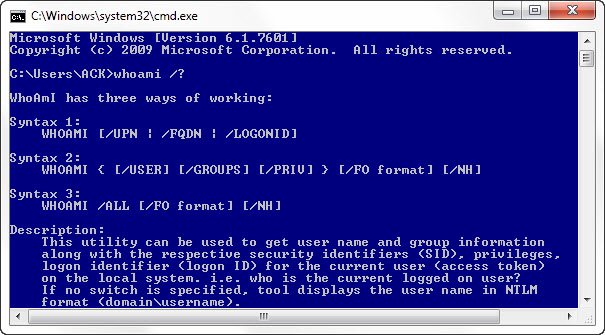WHOAMI utility in Windows 11/10 and its use, syntax, commands
Not many of you may be aware of it, merely Windows has a command-line utility chosen the WHOAMI utility (Who Am I). With this utility, you tin find out the name of the account that's currently logged on, its SID, the names of the security groups of which information technology's a fellow member, and its privileges. The tool is available in Windows xi/10/8/7/Vista and it is also available as part of the Windows Resource Kit.
WHOAMI in Windows eleven/10

The whoami utility can be used to go the user name and group information along with the respective security identifiers (SID), privileges, logon identifier (logon ID) for the current user (access token) on the local system. i.e. who is the currently logged-on user? If no switch is specified, the tool displays the user name in NTLM format (domain\username).
To use whoami, run cmd.exe first.
To learn the name of the logged-on user, just type whoami and hit Enter. This is particularly useful if yous're logged on equally a standard user, but running an elevated Command Prompt window.
For a complete listing of Whoami parameters, and for learning nigh the syntax, type whoami /?
Hither is the complete parameter list for WOAMI
WHOAMI Parameter Listing:
- /UPN : Displays the user name in the User Primary Proper noun (UPN) format.
- /FQDN : Displays the user name in Fully Qualified Distinguished Name (FQDN) format.
- /USER : Displays data on the current user along with the security identifier (SID).
- /GROUPS : Displays group membership for current user, type of account, security identifiers (SID) and attributes.
- /PRIV : Displays security privileges of the current user.
- /LOGONID : Displays the logon ID of the current user.
- /ALL : Displays the current user name, groups belonged to along with the security identifiers (SID) and privileges for the current user access token.
- /FO format : Specifies the output format to be displayed. Valid values are TABLE, Listing, CSV. Cavalcade headings are not displayed with CSV format. The default format is TABLE.
- /NH : Specifies that the column header should not be displayed in the output. This is valid only for Table and CSV formats.
- /? : Displays this assist message.
Promise this helps.

Source: https://www.thewindowsclub.com/whoami-windows
Posted by: rodriguezplad1987.blogspot.com


0 Response to "WHOAMI utility in Windows 11/10 and its use, syntax, commands"
Post a Comment